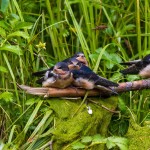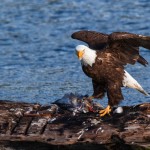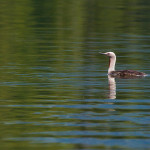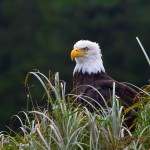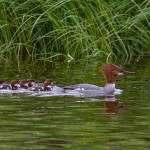-
What is the minimum age required for an expedition?
Based on our experience, Tide Rip has chosen ten (10) years of age as a minimum required to participate in one of our expeditions. Our tours are generally 8 1/2 hours long, too long for young children.
As our excursions are entirely boat-based, that is a two hour commute each way in addition to three to four hours of viewing (which necessitates being both totally silent and absolutely still), it can prove difficult for youngsters to avoid becoming distracted and restless. Not only could that jeopardize the chances of seeing a bear, but it could also compromise the experience of our other guests. Please respect and appreciate our wishes.
-
Are bear sightings guaranteed?
Although we cannot guarantee bear sightings, the vast knowledge and intuition of our Guides based on years of experience and observation will ensure the best viewing potential possible.
The animals we seek to appreciate are wild in every way and although they follow somewhat predictable seasonal patterns of movement and behaviour, they are free to roam throughout their home range.
We can offer this however: the area in which we operate is somewhat unique, affording the bears protection, optimal habitat and a surplus of quality food throughout the year all of which serve to create bear heaven!
-
How close do you get to the bears?
As certified Guides, we have pledged allegiance to guidelines established by the Bear Viewing Association of BC in conjunction with provincial bear biologists. In order to ensure your safety as well as the protection of the animals these regulations dictate how we behave in the company of bears.
For a comprehensive examination of the Best Practices please refer to: bear viewing best practices
In short, it’s a very difficult question involving many different variables including weather, tides, bear behaviour and the presence of other vessels. We endeavour to maintain 50 m of swimmable water between ourselves and the animals.
-
When is the best time to come?
Truth be told, there is no ‘best’ time to come. Each and every season offers it’s own amazing viewing experiences.
In early spring as the winter snow begins to melt, bears emerge from their hibernation dens high on the mountain slopes in a desperate search for food.
The famished bears actively seek out estuarys where they graze nearly every waking hour on nutrient-rich spring sedge grasses and/or forage along the exposed intertidal zone when the tide permits.
Although relatively high in protein, the sedge grasses provide little in the way of calories. Grizzly bears are forced to conserve energy at this time of the year, often draping themselves over anything and everything in the most photogenic way.
During the early spring love is in the air! May and June is breeding season and offers the opportunity to see otherwise large elusive males reluctantly reveal themselves in their pursuit of love. Courtship rituals, mating behaviour and defense of love interests are definitely a spectator’s sport!
As well at this time of the year, the cub-of-year are at their smallest. Imagine the curiosity and mischief they find themselves in after months of being held captive in their dark, damp dens only to have a second birthing of sorts into a new world full of sensory overload!
Although no one can predict with any degree of accuracy exactly when or how big the salmon run will be for any given year, generally the fish will arrive sometime in early to mid-August. The low tide exposes expansive tidal flats over which the fish must migrate through shallow channels where the hungry mouths of Ursus horribilus await them! This can be a very exciting time of the year because under certain circumstances we can position our viewing skiffs in such a way as to provide front row seats for one of the greatest shows on Earth!
By September the fish have largely entered the river and spawning has commenced. The bears will strategically place themselves at shallow riffle zones or simply patrol the river, looking for foraging opportunities in still deep pools or log jams where salmon carcasses will come to rest.
-
Where is your office and how do I get there?
Our office is situated in Cove Coffee Shop at the end of the boardwalk, Telegraph Cove BC.
Having arrived from Highway 19, descend down into beautiful Telegraph Cove and find public parking located immediately on your right. Park your vehicle here. If you have not prepaid for parking, you needn’t worry about doing so at this time but rather upon return to Telegraph Cove in the afternoon. Immediately across from the paid parking please note the red building which is the last public toilets before boarding our boats.
Now it’s a matter of obeying your nose! Follow the smell of fresh-brewed coffee on the western (left hand) side of the Cove. Please continue down the boardwalk until you see our sign directly across from the Prince of Whales Whale Watching office. Even if you stop to appreciate a bird (or maybe a bear!) along the way, it might take you 5 minutes at a slow amble.
-
Will I get sea sick?
Not likely. At least nobody has yet.
Generally it’s the rolling motion of the open ocean that instigates sea sickness. For the most part our certified Captains navigate the sheltered backwaters of the Broughton Archipelago, a maze of islands and islets, rocks and reefs that afford protection from wind and waves.
That’s not to say that things can’t get a wee bit spicy! High pressure systems associated with summer can generate afternoon anabatic winds from the Northwest. If these winds are in opposition to the direction of an ebbing tide one can expect some bumps for part of the journey. Rest assured though that our Captains are well versed in monitoring the localized weather, interpreting marine forecasts and predicting short term trends to ensure a safe and comfortable ride.
-
What else is there to do in Telegraph Cove?
Northern Vancouver Island could very well be one of the best kept secrets. Recreational opportunities are abound and limited only by one’s imagination and for the wildlife enthusiast it is paradise! For a list of Tide Rip-approved ideas and suggestions of hidden nooks and crannies to explore please visit: what to do on Northern Vancouver Island.


